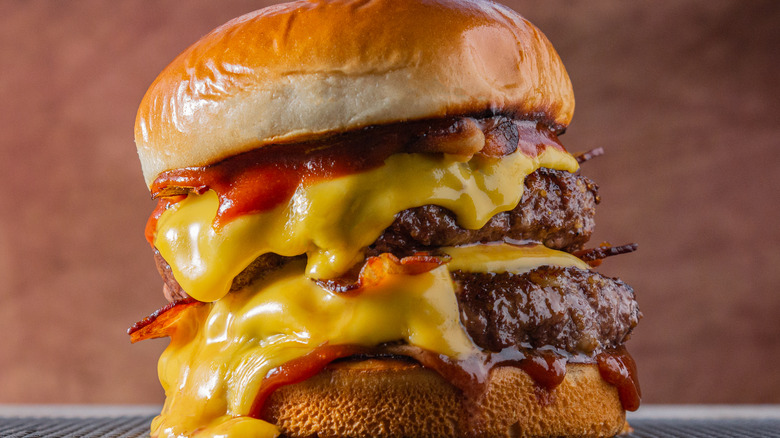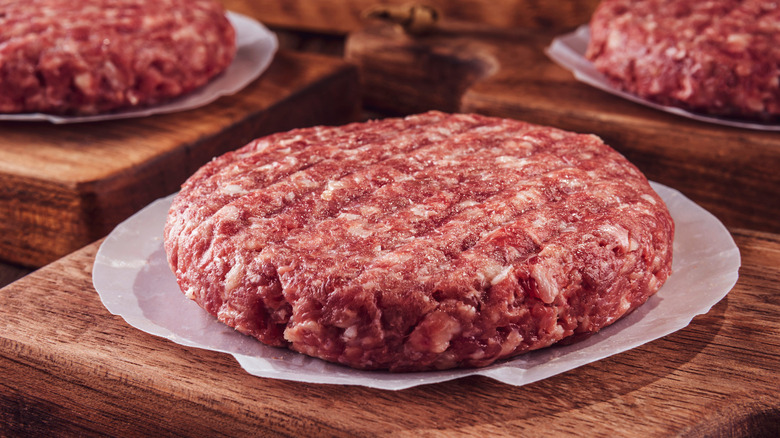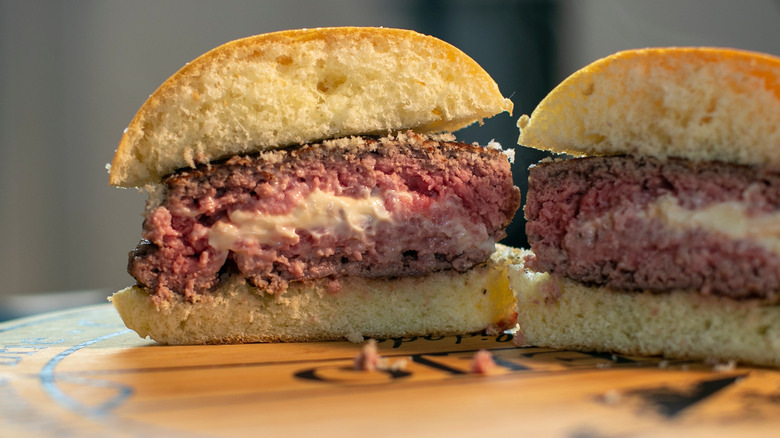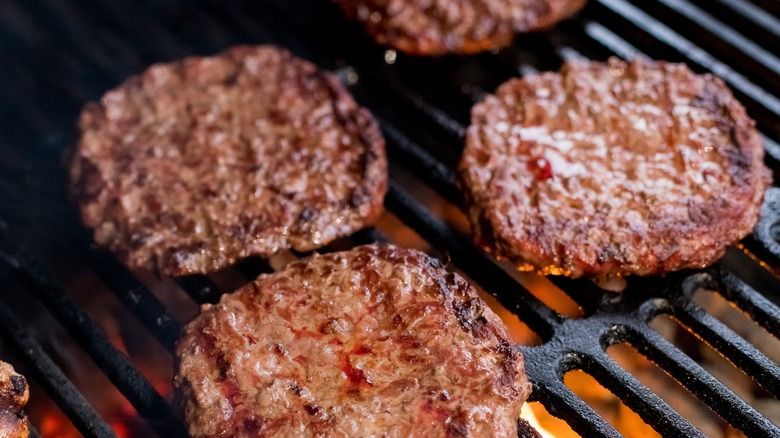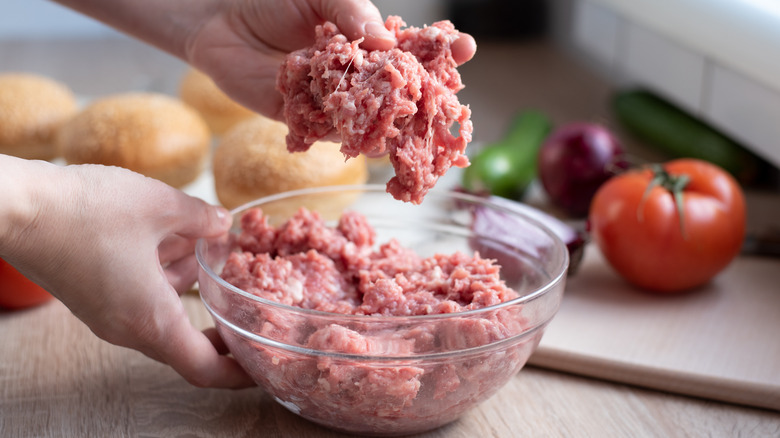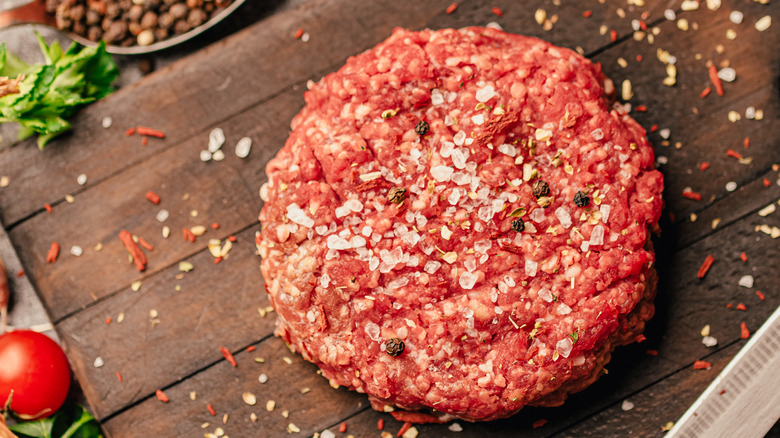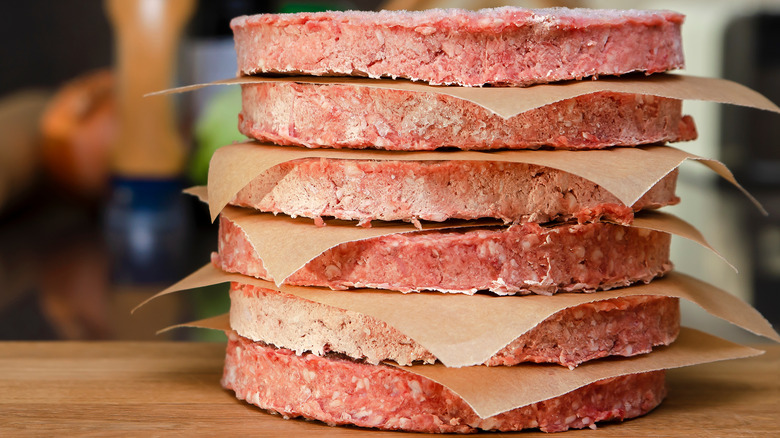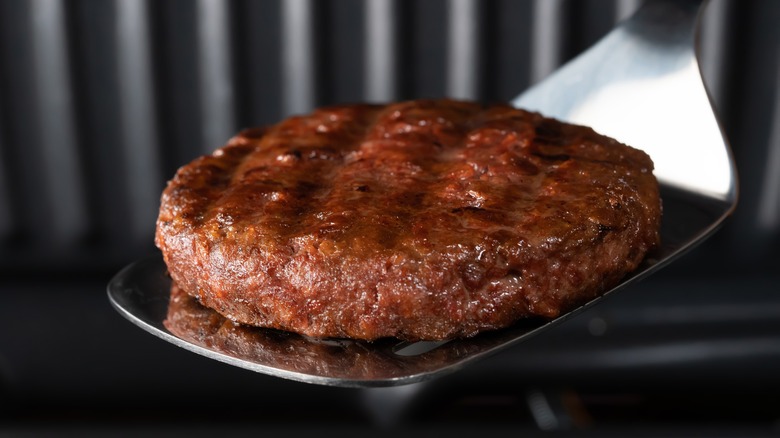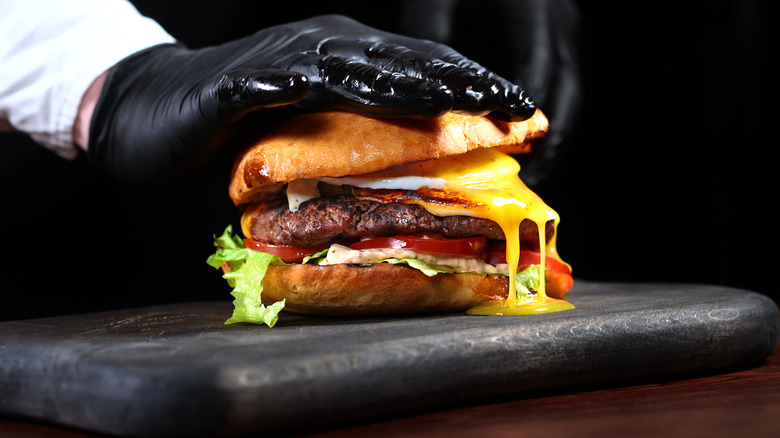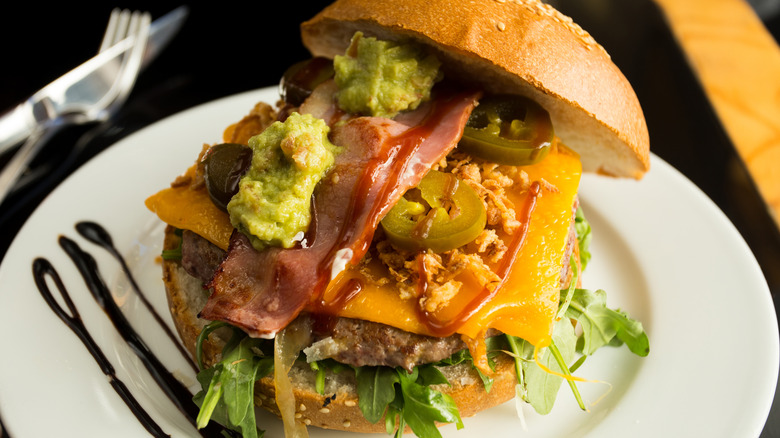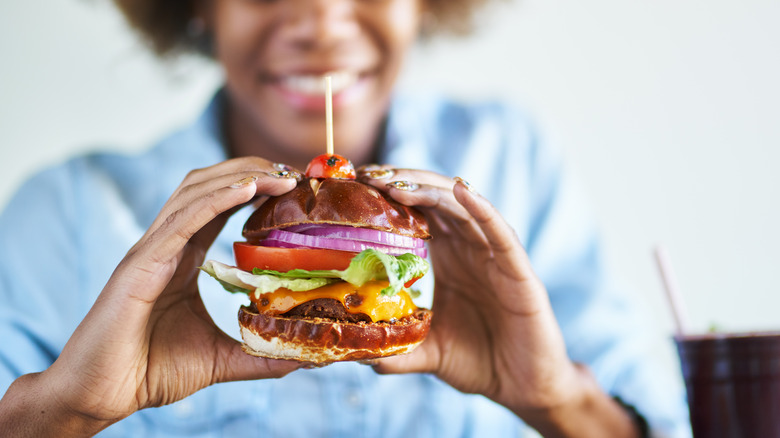10 Ways To Upgrade Your Burgers
The burger is easily one of the most popular and consumed foods in the United States, but burgers, as we know them, have certainly evolved since their origins. It wasn't until the mid-1800s that hamburgers became a thing in the States after an influx of German immigrants brought their beloved ground beef patties with them. Burgers originally began as various versions of chopped steak, eventually gaining a bun for a more finger-friendly meal for food wagons and fairs. It wasn't until White Castle was founded in 1921 that burgers became more of a staple in restaurants (via History).
Today, burgers have transformed into somewhat of an anything-goes sandwich, with toppings ranging from traditional cheese, lettuce, and tomato to the more extravagant and unique, like french-fried onions, eggs, and cole slaw. According to Insider, even some of the most well-known chefs on the planet concoct new versions of the burger with flavorful sauces, meat blends, and various cheeses and toppings for one-of-a-kind results. If you're looking to upgrade your burgers like the pros do, check out the following tips.
1. Use the right kind of beef...but don't be afraid to mix other meat
Apparently, a burger is only as good as the meat you use to make it. Choose low-quality meat, and you may end up with a low-quality burger. Therefore, knowing what to look for in the best beef for your burgers could be all the upgrading you need. According to the University of Illinois Urbana-Champaign Illinois Extension, it's best to choose ground chuck beef with a mixture of 20% fat and 80% lean beef to keep it juicy. If you want a leaner burger, opting for 10% fat and 90% lean beef works too, as long as you're careful about how you cook it. Also, chef Craig Diehl (via Eater) states the importance of choosing dry-aged beef, which adds a "richer, deeper, meatier flavor" to the burger.
That doesn't mean you need to stick solely with ground beef to make a good burger. Some chefs mix in other kinds of meat for additional flavor or texture. For instance, chef Michael Symon (via Epicurious) says, "I like a 1:1:1 ratio of short rib, sirloin, and brisket that's coarsely ground because I think it tastes more like a steak." And, Ina Garten (via Insider) mixes chuck and sirloin together for her burgers.
2. Add some ingredients to the middle
Imagine biting into a juicy burger and being surprised by hidden ingredients in the middle. If you enjoy non-traditional burgers, you'll probably love the idea of a stuffed burger, which many modern chefs are adopting to create new and interesting options. For example, chef and Food Network host Sunny Anderson makes a bacon, cheese, and onion mixture to stuff inside her burgers (via Food Network). And, chef Tyler Florence also uses bacon and Monterey Jack cheese to form small balls sized perfectly to tuck into the middle of a burger patty (via Food Network).
Not sure how to stuff your burgers properly to ensure all the stuffing stays inside? A YouTube video from Marc's on the Grill suggests using a burger press that's specifically designed for stuffed burgers to form the patty. The right press will have a larger section to press the patty and a smaller section that forms a crevice for adding stuffing. Add cooking spray to the press before pressing the top into the patty to form the stuffing crevice. Then, add your stuffing. Next, press a small amount of ground meat between two pieces of patty paper until you form a thin disc to add to the top of your burger. Finally, use the top of the burger press to press the disc and burger meat together to create the final patty.
3. Keep those patties together
One of the easiest ways to have a big old burger fail is to not bind your meat properly. When your ground beef doesn't bind together, it will fall apart in chunks when you try to cook it. Overmixing the beef with your hands is a surefire way to help it fall apart. Instead, only mix the beef with your hands until the ingredients are well combined and you've shaped the patties. After that, stop. Overmixing can cause the patties to firm up, which can also lead to crumbling (via Beef2Live).
Another tip: A good, held-together burger typically needs some fat. One cooking enthusiast on Reddit suggests the go-to 80/20 ratio of lean-to-fat beef to have enough fat to hold the meat together. If you go leaner, be sure to add in some egg or mayo for a little extra binding fat. If you don't have eggs or want to go egg-free, try an egg substitute like a flax seed and water blend or mashed avocado (via Today).
4. Know how to shape your patties
Next, let's talk about shaping your burger patties. Why is this important? Think about the burgers you order from your favorite restaurant: They're most likely cooked to your preference, have just the right amount of thickness, and are almost perfectly rounded to add to their appeal. Professional chefs have mastered the art of patty shaping to craft the best burgers, and it's unlikely that you'll see them throwing one together willy-nilly.
Food Network illustrates the process, starting with a 5 to 6-ounce portion of meat. Toss it between your hands until it forms into a neat ball. Chef Michael Symon (via Epicurious) says it's important to avoid packing the burger too tightly, adding that you should "form it until it just holds together." One of chef Bobby Flay's best secrets for making burgers is to use the thumbprint technique. In a Today article, Flay says that simply making a round patty doesn't suffice. "It plumps up like a football [when cooking] and people smash it down. That's the last thing you want to do," Flay explains. Instead, after forming your round patty, press your thumb into the center of it to flatten it down a bit and prevent it from plumping when cooking, resulting in a more even cook.
5. Learn the right seasoning techniques
We don't know of anyone who'd prefer to eat a bland burger over a well-seasoned one that triggers happiness on your palate. Like most foods, burgers simply taste better when they're seasoned properly. And, like steak, the flavor of ground beef can be enhanced by a sprinkle of salt. However, Cook's Illustrated says there's a right time to salt the patty — and it's not during the shaping phase. Instead, sprinkle salt on the surface of the burger patty just before you're ready to cook them. If you season ground beef with salt before forming them into patties, the chemical composition of the meat changes, which could strip its tenderness away.
As for other seasonings, you can typically add them right to the beef mixture to season the meat before you form it into patties. Grillmaster Redditors mention ground black pepper, cayenne chili powder, and garlic powder as a few top choices. Some also rely on premixed seasonings designed specifically for burgers and beef to add just the right amount of flavor to their patties.
6. Know how to cook frozen patties safely
Some may say never to cook a patty from frozen, but others say it's perfectly okay, especially if you know how to do it safely. The problem lies in ensuring each burger is cooked thoroughly since the outside of a frozen patty typically cooks quicker than its inside. According to the USDA's Food Safety and Inspection Service's Meat and Poultry Hotline, start by cooking the patties away from your grill's direct flame to avoid scary flare-ups that could result in burns and potential scorching of the patties. Then, use a meat thermometer during the cooking process to check that the thickest part of each patty reaches a minimum of 160 degrees Fahrenheit, which means it's safe for eating. After that, you're free to move the burgers over a direct flame to sear each side.
If you have some time to spare before you need to cook your burgers, you may want to do a quick-thaw method — like using your microwave's defrost setting – to make it easier to get the temperature right when cooking. For an even safer route, Tracey Brigman, an associate director for the National Center for Home Food Preservation at the University of Georgia (via Martha Stewart), suggests putting the patties in a leak-proof bag and placing them in a bowl of cold water. Change the water every 30 minutes to keep it cold as it defrosts. Alternatively, continue running cold water over the bag until the patties thaw.
7. Be patient when cooking your burger for the best results
Patience while cooking burgers is crucial to getting them right. One of chef Michael Symon's top 10 rules for burger-making is to flip the burger only once. "The char is a really important part of the flavor. If I get a burger that doesn't have that great caramelization, I'm not happy," says Symon (via Epicurious). According to Symon, understanding the time it takes to cook a burger to a specific temperature, like medium-rare, can help you avoid flipping it back and forth to try to cook it faster. Instead, expect it to take about three to five minutes before flipping it for a medium-rare cook or about two minutes before flipping for a rare burger. Most importantly, Symon advises using a meat thermometer for the most accurate temperature gauge.
Another tip: Don't squish the burger patty with your spatula. It seems that some people do this to flatten the patty more and aid in its cooking. However, beef company Laura's Lean explains in an Instagram post that doing that is actually harming your burger. "Don't squish meat, because you will squeeze out the taste and moisture," explains the post, which adds that flattening the meat releases fat which, in turn, releases much-needed juiciness.
8. Keep your patties moist
No one wants to eat a burger that's reminiscent of a hockey puck. The best burgers are flavorful and juicy. You know that pressing down on hamburger patties can effect their juiciness, but there are a few other ways you can lock in that moisture, too. For example, chef Eric LeVine tells StyleCaster that you can baste the burger with some bacon fat before cooking to enhance its flavor and juiciness. Of course, you'll want to do that before you add it to the grill to avoid dangerous flare-ups when the extra fat hits the flame (via America's Test Kitchen).
A Tesco YouTube video also lends a couple of tips. First, use the lid for your grill or pan to trap steam rather than let it evaporate. If you don't have a lid, place a large enough pan upside down over your burgers to hold steam inside. You can also place small ice cubes in the center of each patty. As they melt, their moisture penetrates the patty to prevent them from drying out. Finally, America's Test Kitchen suggests letting your patties rest for a few minutes after cooking to help the meat reabsorb some of the lost juices.
9. Be mindful of how you top off your burger
Since you're looking to upgrade your burgers, you probably want some unique burger topping ideas to make them stand out. If you've watched top chefs cook burgers, you've probably noticed that they don't tend to stick with traditional, simple toppings, like lettuce, tomato, and pickle. The great thing about a burger, after all, is that it's versatile. For example, green chiles, barbecue sauce, grilled pineapple, and pesto mayo can all work wonders to liven up a burger and make it different from any other one you've eaten.
As you can see, there's no right or wrong way to choose your burger's toppings. If you know how to combine ingredients that complement each other, you can probably make a tasty burger. However, there is a right way to stack your burger, according to head chef of Patty & Bun Fred Trussel (via the Great British Food Awards). "First, you should start with the bun, then add the ketchup and the lettuce to catch the juices from the burger," Trussel says. Then, it's safe to place your patty, cheese, and the rest of your toppings.
10. Don't be afraid to try a new kind of bun
One of the absolute easiest ways to give your burgers a boost is to swap out boring hamburger buns with something new. For example, MasterClass suggests using crispy, crunchy ciabatta bread as burger buns. Wendy's has also revolutionized the popularity of the pretzel bun, which it uses for its Pretzel Bacon Pub Cheeseburger and other menu favorites dating back to 2013.
One Reddit thread had people sharing their absolute favorite types of burger buns. Top choices from commenters include brioche buns, potato rolls, and onion buns. However, other Redditors also mention using Hawaiian buns, sourdough bread, and Texas toast, essentially reimagining the burger as we know it. Although lots of other commenters also chimed in with different suggestions, there seems to be a running theme, no matter which type of bread you go with: Toast it! One Redditor said they prefer brioche, "buttered and toasted on the inside only." Another commenter said, "I'm a sesame seed bun guy. Brush with butter, toast on the grill while the patties are resting... beautiful."
